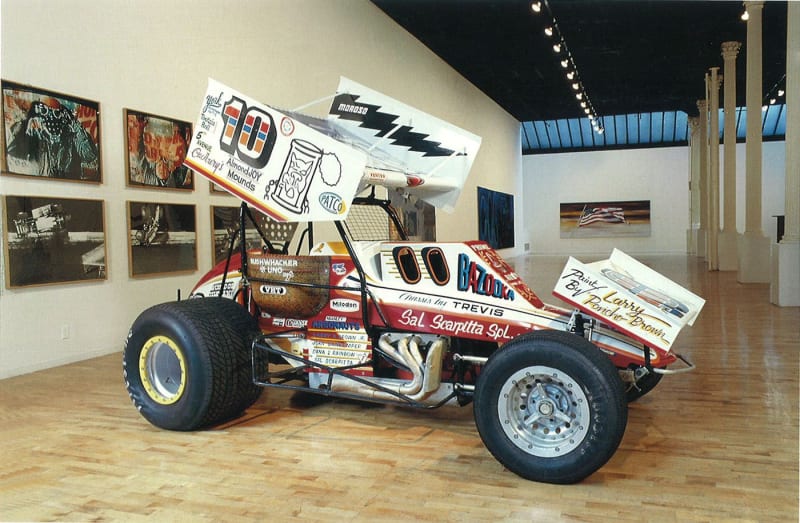BY JESSICA DAWSON
Race cars have long ignited great passions, but American artist Salvatore Scarpitta shifted his devotion into a whole new gear.
The painter and sculptor's obsession is on display in "Salvatore Scarpitta: Traveler," which opens Thursday at the Hirshhorn Museum and Sculpture Garden in Washington, D.C., bringing together 19 works including two full-size cars.
Scarpitta, who died in 2007 at age 88, never outgrew his love of sprint-car racing. In his work, he referred over and over to races he saw in the 1930s at Los Angeles's Legion Ascot Speedway near his childhood home. At the time, the sport was in its infancy, with drivers competing in stripped-down vehicles, often on dirt tracks at fairgrounds.
The Hirshhorn show chronicles the latter half of Scarpitta's career and his fascination with the risks of the racetrack. His paintings often included scavenged parts such as exhaust pipes and safety belts. Then the artist's eureka moment happened: The lean, muscular and often beautifully decorated cars, he realized, were artworks unto themselves.
"He was completely obsessed," said Melissa Ho, an assistant curator who organized the show. "He talked about the total sensory experience—the noise, the smell of the fuel. It was probably his first exposure to such an intense life-or-death experience."
Scarpitta never raced professionally but watched the sport develop a national following. Today, sprint-car racing continues at tracks in California and the Midwest as well as in central Pennsylvania. Major races such as the Knoxville, Iowa, Nationals, are televised.
The sprint cars Scarpitta grew up with were treacherous contraptions, consisting of powerful engines bolted on to four wheels. Drivers were boxed into their vehicles by just a few strips of metal. Few bothered to strap themselves into their seats, figuring it was less risky to be thrown from a wreck than crushed by one.
In his late teens, Scarpitta moved to Italy to study at the Academy of Fine Arts in Rome. Shortly after World War II began, he was declared an enemy alien and interned; later, he went into hiding in the mountains. In 1944, he fled Italy and enlisted in the U.S. armed forces.
After the war, he remained in Italy for more than a decade, pursuing his art. He tore canvas and swaddled it around stretchers, using it as a material and not just a surface for his abstract works. Such pieces suggested the destruction of war as well as the subsequent healing and regeneration.
Scarpitta returned to the U.S. in 1958, when the influential dealer Leo Castelli invited him to join his New York gallery. The artist gravitated back to racetracks, first in New Jersey and later in Maryland and Pennsylvania. Before long, he began affixing car parts, some salvaged from wrecks, to his paintings.
"It's not a coincidence that cars come back in his work when he returns to America," Ms. Ho said. "There are things that connect the kind of intensity that he experienced in the war to the intensity that he saw at play at the track. The difference, of course, is that the drivers are embracing that risk and that intensity of their own free will."
Like the earlier works done in Italy, these pieces feature canvas that has been cut, bandaged and bound—but treated with a brighter palette of oil and enamel paint. It wasn't long before the artist seized on the notion of exhibiting the cars themselves.
"He has this revelation," Ms. Ho said, imagining the artist wondering to himself: "If I'm obsessed with these kinds of cars, why am I translating them into this painting language? I'm just going to make the car."
Between 1964 and 1969, Scarpitta made six full-scale vehicles, including the Hirshhorn's pared-down Sal Cragar, which was inspired by the racers he saw in childhood. The cars were often a mix of antique parts and fabricated ones.
In the 1980s, Scarpitta's studio was in a Baltimore warehouse he shared with a sprint-car driver named Greg O'Neill. The pair met when Mr. O'Neill sold Scarpitta a sprint car, which he exhibited as Trevis Race Car (Sal Gambler Special), a highlight of the Hirshhorn exhibition. The car, which measures nearly 12 feet long, is a riot of red and white paint accented in blue, yellow and orange. The vehicle is splattered with shout-outs to sponsors, drivers and the painters who worked on it.
"Most everything about these cars was handmade," Mr. O'Neill said. "The sprint-car community is very artistic. They always come up with the next-best idea or the next-best design," which fascinated Scarpitta.
The artist bought a racing team in the mid-1980s and persuaded Mr. Castelli and a Washington restaurateur to help back it financially. In a sport where many sponsors hail from the construction business or agriculture, Scarpitta Racing stood out at the track.
"When we came through the gate" with Scarpitta and Mr. Castelli, Mr. O'Neill recalled, "it absolutely made everybody's head turn."

